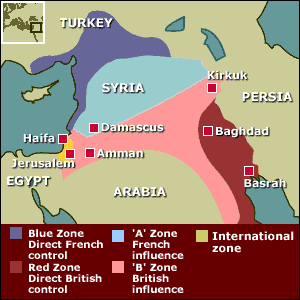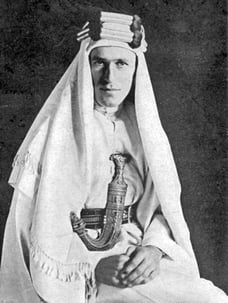Lawrence of Arabia and the Price of a Man's Conscience
(This article first appeared at blogcritics.org on 12 July 2013)
A diamond is not an easy thing to cut unless you know where to start. What you have to do is look for a flaw, or fault line, and if you apply pressure to that point, it will split into facets easily. In some respects attempting to understand a brilliant man like Lawrence of Arabia is the same – to get beneath his brilliance you need to find a fault line, and in T.E. Lawrence’s case, as indeed with so many people, the fault line is his conscience.

It is now part of history that Lawrence gained the cooperation of the Arabs under false pretences. The British promised them statehood if they would rise up against their Turkish overlords, but the Sykes-Picot agreement of 1916 belied that promise, showing instead that Britain and France intended to carve up the Middle East after the war. Lawrence was caught between the devil and the deep blue sea – gaining the trust of the Arabs would help defeat the Turks, and therefore the Germans, but that would only happen if he lied to them.
It was a compromise that was to leave him a broken man. While the physical deprivations he endured certainly took a toll, it was having to live with the knowledge of his duplicity – men were dying in front of him for his promises – that exacted the greater cost. Lawrence left the war with a shattered conscience, adrift between two cultures, “with a resultant feeling of intense loneliness in life, and a contempt, not for other men, but for all they do.”
Christ of course said it will profit a man nothing if he gains the whole world but loses his soul, and Lawrence certainly appears to evidence that, but in order to properly understand this fault line that is Lawrence’s conscience, it is perhaps first necessary to try and better understand just what conscience is – and that ultimately is a scientific endeavour.
There are a lot of theories about what it means to be human, and about the apparent contradiction between our selfish need to reproduce and carry on our genes on the one hand, and concern for others – our selfless moral sense or conscience – on the other. However, much of the current scientific thinking has been accused of being too reductionist and overly mechanistic, and not really capturing the psychological aspect of what it is to be human and have a conscience.
One scientific theory that offers the prospect of insight into the moral anguish that wracked Lawrence and eventually left him shipwrecked is provided by the biologist Jeremy Griffith. Griffith suggests that we possess genuinely selfless moral instincts, of which our conscience is the voice, and that our current state, characterised by angry, alienated and egocentric behaviour, is psychologically derived, the result of a two-million-year-old, unavoidable clash between our instincts and our emerging consciousness. Griffith suggests that our instincts in effect ‘criticised’ our conscious experiments in self-management, and humans live in a state of insecurity and permanent guilt as a result. This state of turmoil he calls the human condition.
Living under the duress of the human condition has meant we all block out our conscience to a large degree, but a look at some of the different strategies within this umbrella offers the promise of insight into Lawrence’s particular character.

As a starting point, blocking out the criticism from our conscience is often accompanied by a retaliation against it, and this would account for a lot of the anger and aggression in our lives. Another common strategy is to simply replace your conscience with persuading yourself that if you are meeting your cultural norms then you are ‘good’. There are also those who attempt to keep some access to their conscience, despite the anguish it causes them, and take pride in the endeavour. Such a strategy appeared to be Lawrence’s.
If this is true, it explains much about Lawrence. He had in him an ascetic streak, whereby he welcomed extreme hardship, almost as though he sought to make restitution for the age-old schism within himself between instinctive conscience and rebellious consciousness: “I was busy compartmenting my mind” he said, “finding instinct and reason as ever at strong war.” His most burning ambition was that he might again know that part of life which the battle of the human condition had caused him to be excluded from: “Shall I ride on this time, beyond Khazail, and know it all?” he asked of himself, but the prospect, without a proper defence for our intellect’s disobedience, was too terrifying, and Lawrence could only refer to “that glowing square which my timid anticipation never let me reach”.
This inclination toward asceticism was apparent in Lawrence from his early teens, when with what now appears to be extraordinary prescience, he began to train himself by going without food for long periods of time; at other times he would practice eating all manner of food in order to train his body to operate efficiently whatever the diet. After leaving school he went on a three-month walking tour in Europe, during which time he hiked some 1,600 kilometres. It was a drive that was to make the desert with its promise of hardship and deprivation all but irresistible.
As it was, when World War One broke out, and British Intelligence wanted to start an Arab revolt, Lawrence, who as a result of his wanderings had by then become an Arab expert, was the natural candidate to spark it.
The revolt was intended to create what in military terms was known as an ‘asymmetry’. In an asymmetry, a large amount of your opponent’s resources can be engaged by using only a small amount of your own. Convincing and then leading small bands of camel-mounted Arabs to harass and sabotage the Turks’ 1,300 kilometre Hejaz railway line, thus forcing the Turks to defend its entire length, presented just such an asymmetrical scenario.
As history shows, the strategy was a success. Lawrence and his fanatical band of followers not only tied up thousands of Turk soldiers by regularly blowing up sections of the railway, but they went further and audaciously captured the strategic town of Aqaba, and even played a large role in the fall of Damascus. However, Lawrence was increasingly guilt-stricken. When he rode off to enter Damascus, alone and with the Turks’ 15,000-pound bounty on his head, he wrote a tortured note to his chief in Cairo: “Clayton, I’ve decided to go off alone to Damascus, hoping to get killed on the way… We are calling them to fight for us on a lie, and I can’t stand it.”
In the years following the war, Lawrence was to became a hero in the popular mind, an image fuelled by exotic images of himself in flowing Bedouin robes. But he shunned any public recognition, refusing the Distinguished Service Order and the insignia of a Companion of the Bath from the hands of King George V, and also the king’s offer of a knighthood; he even went so far as to change his name in order to gain anonymity – all measures which perversely contributed to the myth that was growing around him.
There is no doubt the adoration and attempts to reward him amplified his guilt, and it is not too far a stretch to say that this guilt contributed to his death. After the war Lawrence took to riding his beloved motorcycles full-tilt through the countryside, as a sort of psychological relief-valve. From his own descriptions of the risks he took during these rides, it would seem that a fatal crash was inevitable, and sadly, that is what transpired. In 1935, as he was riding fast along a country road in Dorset, a dip in the road hid two boys on bicycles, and when Lawrence tried to avoid them he was thrown, and fatally injured.
Seen through the lens of Griffith’s explanation, Lawrence’s experiences during the war meant that his life’s strategy as a man of conscience no longer worked for him – simply put, because of his duplicity Lawrence could no longer convince himself that he was good; the fault line through his character had become a chasm.
It is perhaps in recognition of the extreme personal sacrifice that Lawrence made, more so than even his military success, that led the government to place a bust of Lawrence in the crypt of St Paul‘s alongside the tombs of Britain’s greatest heroes including the Duke of Wellington and Admiral Nelson.




Please wait while the comments load...
Comments